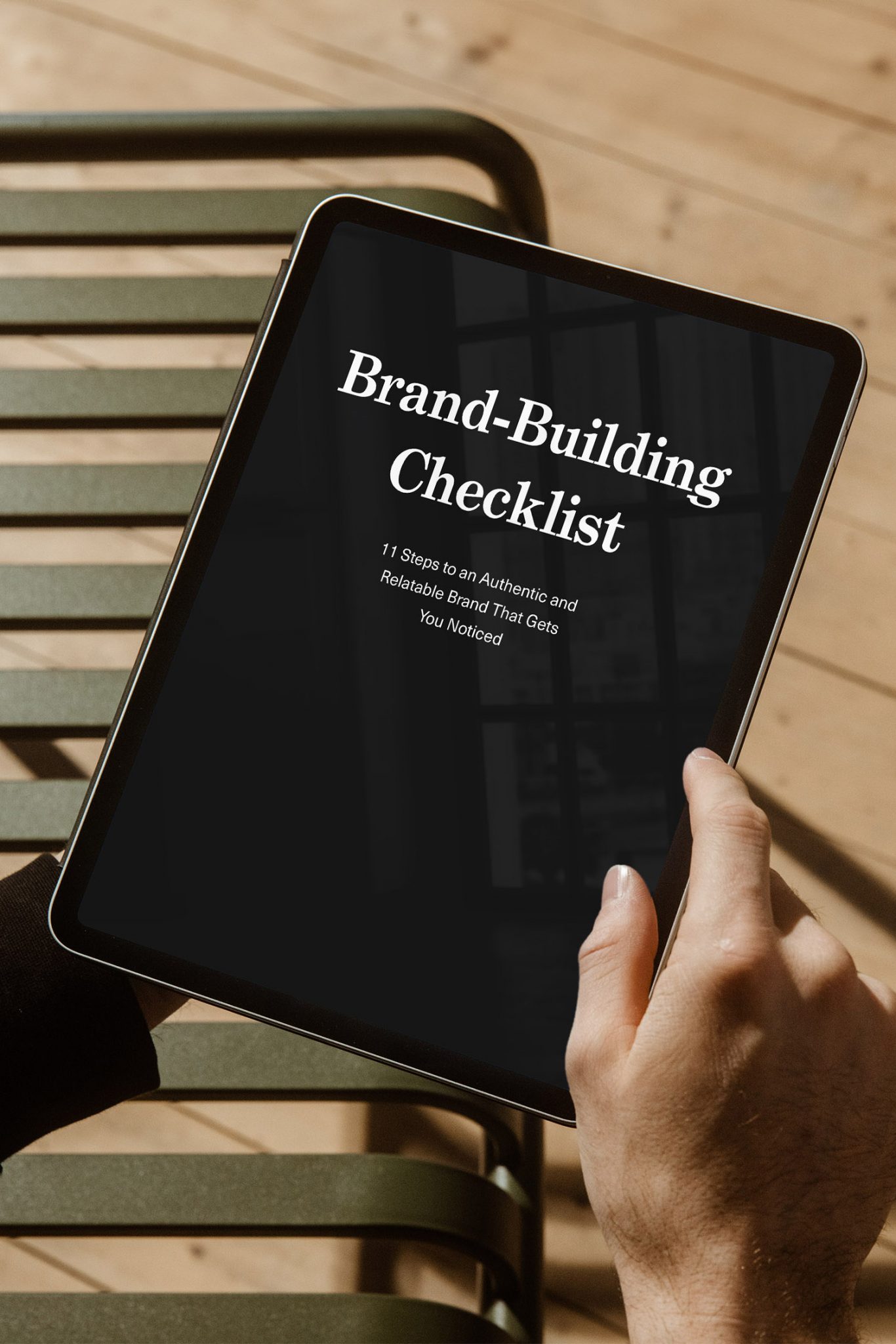Your branding is the face of your business. It’s what people recognise, judge, and remember about your company. Hence, it should reflect a consistent image and instil trust in your brand. But how can you ensure every message looks and sounds from the same source? That’s where brand guidelines come in.
You may have come across other terms, like
- brand manual,
- brand handbook,
- brand style guide,
- or corporate brand guidelines.
Despite the different names, they all serve the same purpose: ensuring consistency in your corporate communication.
Let’s stick to the term ‘brand guidelines’ in this article because it doesn’t stop at the visual identity.
As the business landscape evolves, brands become more complex and human—almost like living organisms.
Instead of just a logo and a brand colour palette, brands now have personalities, stories to tell, and quirks that make them unique.
It can be challenging not to lose track of all these features and characteristics without documenting them in brand guidelines.
This brings us to the big question: How can you create useful brand guidelines for your business?
Let’s find out below. By the end of this article, you’ll know what brand guidelines are, why you need them, what to include, and which format is best suited for your specific needs.
What are Brand Guidelines?
Brand guidelines are detailed instructions that define how your brand is presented across different channels, platforms, and brand touchpoints.
They serve as a reference to ensure that your brand’s identity maintains consistency and uniformity across all forms of communication, be it visual, verbal, or otherwise.
For more branding definitions, you might like my Brand Glossary.
Benefits of Having Brand Guidelines
You may think of your brand assets—your brand name, logo, brand fonts or voice—as the most valuable aspects of your communication.
And they are. But without clear guidelines on how to use them, they contribute little to maintaining a consistent identity.
That’s why brand guidelines prove invaluable. Here’s how you can benefit from them:
Consistency and Brand Recognition
When you stick to your brand guidelines, all communication, from emails to ads, will appear from the same source, even with multiple authors involved.
This consistency helps you create a uniform and recognisable brand image and anchor your brand identity and name in people’s minds.
I cover this in more detail in What Makes a Brand Recognisable?
Communicating Professionalism
Well-defined brand guidelines make it easier to maintain a professional image.
People unfamiliar with your company form an opinion about its quality based on its representation alone. Think about it—how else are they supposed to judge your expertise?
This is due to the so-called Halo Effect, a mental shortcut in our decision-making.
Building Trust
If people are repeatedly confronted with this same positive brand image, they are more likely to trust your brand. They might even become loyal fans.
Efficiency in Communication
Thanks to your brand guidelines, everyone working on the brand is on the same page. Elements such as layouts, colours and fonts are largely pre-defined.
Internally, your brand guidelines help your employees understand and adhere to your brand identity.
Externally, your brand guidelines provide new partners with all the relevant information about your brand and ensure seamless integration into your established style.
Differentiation
Clear rules also help your brand stand out.
Firstly, they help you adhere to your brand elements for a uniform and unmistakable image.
Secondly, they prevent you from aimlessly copying other companies and following trends.
Elements to Include in Your Brand Guidelines
The scope of your brand guidelines can vary based on your unique requirements.
You may include information on your
- Target audience
- Brand foundation (brand positioning, mission, vision, values, essence, brand personality)
- Visual identity (logo, typography, colours, patterns, …)
- Verbal identity (naming, tone of voice, messaging, storytelling)
- Other brand elements, such as scent or sounds
- Examples of the brand in use
Let’s look at these elements in more detail.
1. Target audience
- Who is your primary target audience?
- How old are they?
- Where do they live?
- What is their profession?
- Where do they hang out?
- What are their typical behaviours (online and offline)?
- What interests them?
- What do they value?
- Which brands do they support and why?
- How do brands help them express themselves?
- How do they usually interact with content or products?
- Can you identify different groups (segments) within your audience?
2. Brand Foundation
Positioning
- How do you want to position your brand in people’s minds? How do you want them to perceive it?
- What makes your brand stand out from the competition?
- What emotions or associations do you want to evoke?
- What qualities do you want customers to associate with your brand?
Essence
- What is the essence or soul of your brand in under 5 words?
Mission
- Beyond profit, what are your brand’s long-term goals?
- What contribution does your brand make to society or the wider industry?
- What impact does your company want to make?
Values
- What is your unique value proposition?
- What values does your company share with its target audience?
- Which values are non-negotiable for your brand?
- How are these values reflected in your operations?
Brand Personality
- How would you describe the personality of your brand?
- Which human traits best represent the brand?
- If your brand were a person, who would it be?
- Who would it surround itself with?
- What feelings do you want the brand to trigger in people when they interact with it?
3. Visual Identity
Logo
- Where is your logo used?
- How is the logo placed relative to other elements?
- What is the minimum distance between the logo and other elements (clearance)?
- Which backgrounds are suitable?
- Are there different versions of your logo for different use cases? For example, will the logo be adapted to smaller sizes to remain legible?
- Which logo file formats are preferred for each application?
- What is the minimum size to maintain quality and legibility?
- Are there specific colour standards for the logo?
Brand Typography
- Which brand fonts or typefaces are used?
- Are different fonts used for headings and body text?
- Are some fonts associated with specific functions or contexts?
- What rules apply to text sizes and proportions (consider using type scales)?
Perhaps you find my article with 20 typography tips helpful when choosing your brand typography.
Colour Palette
- What are your brand colours—primary, secondary and accents?
- Do specific colours represent different aspects or functions of the brand?
- Are there guidelines on colour combinations and proportions?
- How are colours adapted for various platforms or mediums?
You should also include different colour profiles for uniformity across applications:
- CMYK: Used in the four-colour printing process for brochures, business cards, etc.
- RGB: Used for digital applications, primarily for screens.
- HEX: Used in web design for consistency across browsers and devices.
- Pantone: Standardised colour-matching system for specialised printing, such as packaging, signage, and promotional materials
Photography
- Do your brand images (as used on your website, social media, etc.) follow a distinctive photography style?
- Does it use photo filters such as black and white, duotone or other colour tones?
- Are there rules for the subjects in the photos?
- Are certain angles or perspectives favoured?
- What atmosphere should the photography convey?
Other Graphic Elements
- Are elements such as illustrations or icons part of your brand identity?
- Are there certain patterns or shapes associated with your brand?
- What rules apply here?
Layout
- Do you use specific grid systems in your layouts?
- Where should elements like logos, headlines, or CTAs be placed on the page?
- How much white space is required?
Motion & Video
- If applicable: Are there specific considerations for animations and videos? To give you a better idea of what’s involved, you may find this article about creating on-brand videos helpful.
4. Verbal Identity
Tone of Voice
- How would you describe your brand voice?
- What words and phrases are used or avoided?
- Are there specific rules around punctuation?
- Are there variations in the voice for different contexts?
Messaging
- What key messages should be communicated consistently?
- How should your brand be positioned through its messaging?
Brand Storytelling
- What stories should be told to align with your brand identity?
- How do these stories connect with your audience?
5. Other Brand Elements
If relevant, you can include guidelines around distinctive scents, sounds, or textures associated with your brand.
- Are there specific scents associated with your brand?
- How are sounds and textures used in your brand communication?
- How does interior design reflect your brand identity?
- Are there specific architectural elements associated with your brand?
There are no limits. Check out my article on sensory branding for inspiration.
6. Usage Examples
Examples are the heart of your brand guidelines.
Be sure to provide real-world examples that show how brand elements come together and represent your brand across different brand touchpoints, platforms, channels and sizes—for digital and print.
Consider using premium mockups to show how the branding comes to life.
Remember: The goal is to make a guide that helps everyone, inside and outside the organisation, represent your brand consistently and in line with its identity and values.
The Risk of Brand Guidelines
The more detailed your brand guidelines are, the easier it is to maintain this consistency in your communication.
However, there is also a risk of your branding becoming rigid, repetitive and boring.
As your company grows and evolves, your brand guidelines will help you stick to the core elements of your brand identity. However, they should also allow for updates or adjustments to market trends.
That’s why it’s important to review your brand guidelines regularly.
This way, you can find a healthy mix—keeping your brand fresh and creative while maintaining a consistent look and feel.
What Format Should Your Brand Guidelines Have?
- Printed Booklet
- Online Portal
- Video
- Brand toolbox
Printed Booklet
Printed brand guidelines used to be the norm. They are easy to distribute to team members or other stakeholders and provide a tangible reference.
However, printed booklets have some disadvantages: they are difficult to update, not very eco-friendly and not easily accessible from all locations.
The PDF format is a popular format for brand guidelines as it is easy to distribute and update as required. PDF can be opened from all devices and is easy to use.
However, it is less interactive than other digital formats.
Website
Tech firms like Uber often rely on websites for their brand guidelines.
A website, whether on the internal company network or online, is easy to update and access from anywhere.
There is even the option to include videos and other interactive features, such as quizzes or a download function.
The only disadvantages are the effort of creating them and the costs of hosting, designers, developers, etc.
Video
I’ve also seen brand guidelines in video format.
Videos are dynamic and engaging, easy to share and can show the use of each brand element clearly.
With video editing software, you can add music, effects and transitions to make your video even more engaging. You can find a comparison of user-friendly video editing tools in this article.
However, videos on their own can quickly become long and overwhelming. Consider integrating video sequences into your other digital formats.
Brand Toolbox
While large companies rely on detailed brand guidelines, smaller companies can often keep things simple.
Have you ever thought about setting up a brand toolbox?
You could set up a folder in a centralised location such as Dropbox, Google Drive or Notion where you keep all your brand assets along with brief instructions and templates.
This way, your guidelines are readily available and can be customised quickly.
Conclusion
Your brand guidelines help maintain consistency across all brand touchpoints—the key to fostering brand recognition and building trust with your customers.
Comprehensive brand guidelines can include the following elements:
- Brand foundation (audience, positioning, mission, values, essence, brand personality)
- Visual Identity (logo, brand fonts, colour palette, photography, other graphic elements, layout, motion)
- Verbal Identity (tone of voice, messaging, brand storytelling)
- Other Brand Elements (scents, sounds, textures, interior, architecture)
Usage Examples
You can choose from different formats, such as printed booklets, PDFs, websites, videos or brand toolboxes. Depending on your company and its requirements, they are more or less suitable.
While larger companies benefit from detailed guidelines—often in PDF format—smaller companies may be best off with a brand toolbox.
Regardless of the format, your brand guidelines should be flexible enough to allow for changing market trends, business development and new ideas.
Creating brand guidelines is an ongoing process and requires regular reviews.
Finally, you will find many helpful examples in the branding guidelines archive.
If you need help defining your brand guidelines, feel free to reach out.
Title image by Kaboompics






